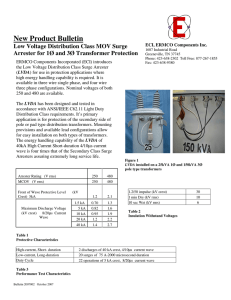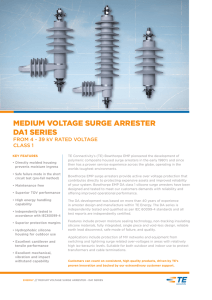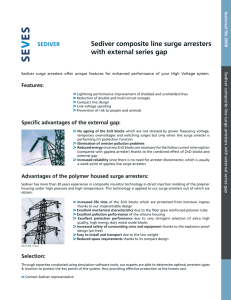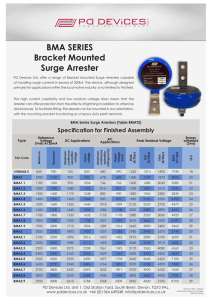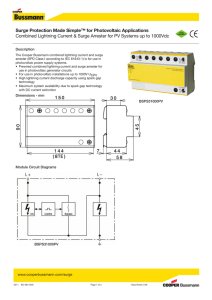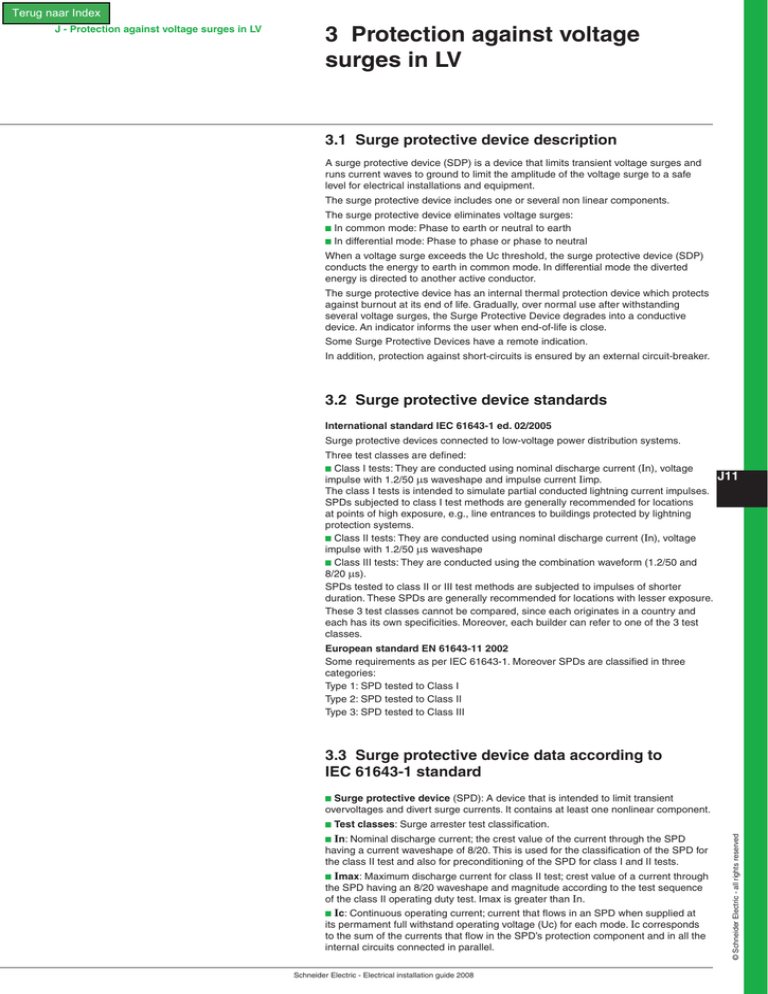
Terug naar Index
3 Protection against voltage
surges in LV
3.1 Surge protective device description
A surge protective device (SDP) is a device that limits transient voltage surges and
runs current waves to ground to limit the amplitude of the voltage surge to a safe
level for electrical installations and equipment.
The surge protective device includes one or several non linear components.
The surge protective device eliminates voltage surges:
b In common mode: Phase to earth or neutral to earth
b In differential mode: Phase to phase or phase to neutral
When a voltage surge exceeds the Uc threshold, the surge protective device (SDP)
conducts the energy to earth in common mode. In differential mode the diverted
energy is directed to another active conductor.
The surge protective device has an internal thermal protection device which protects
against burnout at its end of life. Gradually, over normal use after withstanding
several voltage surges, the Surge Protective Device degrades into a conductive
device. An indicator informs the user when end-of-life is close.
Some Surge Protective Devices have a remote indication.
In addition, protection against short-circuits is ensured by an external circuit-breaker.
3.2 Surge protective device standards
International standard IEC 61643-1 ed. 02/2005
Surge protective devices connected to low-voltage power distribution systems.
Three test classes are defined:
b Class I tests: They are conducted using nominal discharge current (In), voltage
impulse with 1.2/50 μs waveshape and impulse current Iimp.
The class I tests is intended to simulate partial conducted lightning current impulses.
SPDs subjected to class I test methods are generally recommended for locations
at points of high exposure, e.g., line entrances to buildings protected by lightning
protection systems.
b Class II tests: They are conducted using nominal discharge current (In), voltage
impulse with 1.2/50 μs waveshape
b Class III tests: They are conducted using the combination waveform (1.2/50 and
8/20 μs).
SPDs tested to class II or III test methods are subjected to impulses of shorter
duration. These SPDs are generally recommended for locations with lesser exposure.
These 3 test classes cannot be compared, since each originates in a country and
each has its own specificities. Moreover, each builder can refer to one of the 3 test
classes.
J11
European standard EN 61643-11 2002
Some requirements as per IEC 61643-1. Moreover SPDs are classified in three
categories:
Type 1: SPD tested to Class I
Type 2: SPD tested to Class II
Type 3: SPD tested to Class III
3.3 Surge protective device data according to
IEC 61643-1 standard
b Surge protective device (SPD): A device that is intended to limit transient
overvoltages and divert surge currents. It contains at least one nonlinear component.
b Test classes: Surge arrester test classification.
b In: Nominal discharge current; the crest value of the current through the SPD
having a current waveshape of 8/20. This is used for the classification of the SPD for
the class II test and also for preconditioning of the SPD for class I and II tests.
b Imax: Maximum discharge current for class II test; crest value of a current through
the SPD having an 8/20 waveshape and magnitude according to the test sequence
of the class II operating duty test. Imax is greater than In.
b Ic: Continuous operating current; current that flows in an SPD when supplied at
its permament full withstand operating voltage (Uc) for each mode. Ic corresponds
to the sum of the currents that flow in the SPD’s protection component and in all the
internal circuits connected in parallel.
Schneider Electric - Electrical installation guide 2008
© Schneider Electric - all rights reserved
J - Protection against voltage surges in LV
3 Protection against voltage
surges in LV
J - Protection against voltage surges in LV
b Iimp: Impulse current, it is defined by a current peak value Ipeak and the charge
Q. Tested according to the test sequence of the operating duty test. This is used for
the classification of the SPD for class I test.
b Un: Rated network voltage.
b Uc: Maximum continuous operating voltage; the maximum r.m.s. or d.c. voltage
which may be continuously applied to the SPDs mode of protection. This is equal to
the rated voltage.
b Up: Voltage protection level; a parameter that characterizes the performance of
the SPD in limiting the voltage across its terminals, which is selected from a list of
preferred values. This value shall be greater than the highest value of the measured
limiting voltages.
The most common values for a 230/400 V network are:
1 kV - 1.2 kV - 1.5 kV - 1.8 kV - 2 kV - 2.5 kV.
b Ures: Residual voltage, the peak value of the voltage that appears between the
terminals of an SPD due to the passage of discharge current.
The SPD is characterised by Uc, Up, In and Imax (see Fig. J16)
b To test the surge arrester, standardized voltage and current waves have been
defined that are specific to each country:
v Voltage wave
e.g. 1.2/50 μs (see Fig. J17)
v Current wave
Example 8/20 μs (see Fig. J18)
U
J12
Up
Uc
In
< 1 mA
I
Imax
Fig. J16 : Voltage/current characteristics
I
V
Maxi
100 %
Maxi
100 %
50 %
50 %
1,2
Fig. J17 : 1.2/50 μs wave
t
t
8
50
20
Fig. J18 : 8/20 μs wave
© Schneider Electric - all rights reserved
v Other possible wave characteristics:
4/10 μs, 10/1000 μs, 30/60 μs, 10/350 μs...
Comparison between different surge protective devices must be carried out using the
same wave characteristics, in order to get relevant results.
Schneider Electric - Electrical installation guide 2008
3 Protection against voltage
surges in LV
J - Protection against voltage surges in LV
3.4 Lightning protection standards
The IEC 62305 series (part 1 to 5) restructures and updates the publications of
IEC 61024 series, IEC 61312 series and IEC 61663 series.
The need for protection, the economic benefits of installing protection measures and
the selection of adequate protection measures should be determined in terms of risk
management. Risk management is the subject of IEC 62305-2.
The criteria for design, installation and maintenance of lightning protection measures
are considered in three separate groups:
b The first group concerning protection measures to reduce physical damage and life
hazard in a structure is given in IEC 62305-3.
b The second group concerning protection measures to reduce failures of electrical
and electronic systems in a structure is given in IEC 62305-4.
b The third group concerning protection measures to reduce physical damage and
failures of services connected to a structure (mainly electrical and telecommunication
lines) is given in IEC 62305-5.
3.5 Surge arrester installation standards
b International: IEC 61643-12 selection and application principles
b International: IEC 60364 Electrical installations of buildings
v IEC 60364-4-443: protection for safety
When an installation is supplied by, or includes, an overhead line, a protection device
against atmospheric overvoltages must be foreseen if the keraunic level of the site
being considered corresponds to the external influences condition AQ 1 (more than
25 days per year with thunderstorms).
v IEC 60364-4-443-4: selection of equipment in the installation.
This section helps with the choice of the protection level Up for the surge arrester in
function of the loads to be protected.
Rated residual voltage of protection devices must not be higher than the value in the
voltage impulse withstand category II (see Fig. J19):
Nominal voltage of
the installation(1) V
Three-phase Single-phase
systems(2)
systems with
middle point
120-240 230/400(2)
-
277/480(2)
400/690
-
1,000 -
Required impulse withstand voltage for
kV
Equipment at Equipment of Appliances
the origin of
distribution and
the installation final circuits
(impulse
(impulse
(impulse
withstand
withstand
withstand
category IV) category III)
category II)
4
2.5 1.5 6
4
2.5 8
6
4
Values subject to system engineers
J13
Specially
protected
equipment
(impulse
withstand
category I)
0.8
1.5
2.5
(1) According to IEC 60038
(2) In Canada and USA for voltages to earth higher than 300 V,
the impulse withstand voltage corresponding to the
next higher voltage in column one applies.
Category I is addressed to particular equipment engineering.
Category II is addressed to product committees for equipment
for connection to the mains.
Category III is addressed to product committees of installation
material and some special product committees.
Category IV is addressed to supply authorities and system
engineers (see also 443.2.2).
Schneider Electric - Electrical installation guide 2008
© Schneider Electric - all rights reserved
Fig. J19 : Choosing equipment for the installation according to IEC 60364
J - Protection against voltage surges in LV
3 Protection against voltage
surges in LV
v IEC 60364-5-534: choosing and implementing electrical equipment
This section describes surge arrester installation conditions:
- According to earthing systems: The maximum continuous operating voltage Uc
of SPDs shall be equal to or higher than shown in Fig. J20.
SPDs connected
between
System configuration of distribution network
TT
TN-C
TN-S
Line conductor and
neutral conductor
1.1 Uo
NA
1.1 Uo
1.1 Uo
NA
Each line conductor and
PE conductor
1.1 Uo
NA
1.1 Uo
3Uo(1)
Line-to-line
voltage (1)
Uo(1)
NA
Uo(1)
Uo(1)
NA
NA
1.1 Uo
NA
NA
NA
Neutral conductor and PE
conductor
Each line conductor and
PEN conductor
IT with
IT without
distributed distributed
neutral
neutral
NA: not applicable
NOTE 1: Uo is the line-to-neutral voltage of the low-voltage system.
NOTE 2: This table is based on IEC 61643-1 amendment 1.
Fig. J20 : Minimum required Uc of the SPD dependent on supply system configuration
- At the origin of the installation: if the surge arrester is installed at the source of
an electrical installation supplied by the utility distribution network, its rated discharge
current may be lower than 5 kA.
If a surge arrester is installed downstream from an earth leakage protection device,
an RCD of the s type, with immunity to impulse currents of less than 3 kA (8/20 μs),
must be used.
- Protection against overcurrent at 50 Hz and consequences of a SPD failure:
protection against SPDs short-circuits is provided by the overcurrent protective
devices F2 which are to be selected according to the maximum recommended rating
for the overcurrent protective device given in the manufacturer's SPD instructions.
- In the presence of lightning conductors: a surge arrester must be installed,
additional specifications for surge arresters must be applied (see IEC 62305 part 4).
© Schneider Electric - all rights reserved
J14
(1) These values are related to worst case fault conditions,
therefore the tolerance of 10 % is not taken into account
Schneider Electric - Electrical installation guide 2008
4 Choosing a protection device
When installing surge arresters, several elements must be considered, such as:
b Cascading
b Positioning with respect to residual current devices
b The choice of disconnection circuit breakers
The earthing system must also be taken into account.
4.1 Protection devices according to the earthing
system
b Common mode overvoltage: basic protection involves the installation of a common
mode surge arrester between phase and PE or phase and PEN, whatever type of
earthing system is used.
b Differential mode overvoltage: in the TT and TN-S earthing systems, earthing the
neutral leads to dissymmetry due to earthing impedances, which causes differential
mode voltages to appear, whereas the overvoltage induced by a lightning strike is a
common mode voltage.
For example, let us consider a TT earthing system. A two-pole surge arrester is
installed in common mode to protect the installation (see Fig. J21).
I
I
I
J15
I
Fig. J21 : Common mode protection only
The neutral earthing resistor R1 used for the pylons has a lower resistance than the
earthing resistor R2 used for the installation. The lightning current will flow through
circuit ABCD to earth via the easiest path. It will pass through varistors V1 and V2 in
series, causing a differential voltage equal to twice the residual voltage of the surge
arrester (Up1 + Up2) to appear at the terminals of A and C at the entrance to the
installation in extreme cases.
To protect the loads between Ph and N effectively, the differential mode voltage
(between A and C) must be reduced.
Another earthing system is therefore used (see Fig. J22).
The lightning current flows through circuit ABH which has a lower impedance than
circuit ABCD, as the impedance of the component used between B and H is null (gas
filled spark gap).
In this case, the differential voltage is equal to the residual voltage of the surge
arrester (Up2).
I
I
I
Fig. J22 : Common + differentiel mode protection
Schneider Electric - Electrical installation guide 2008
© Schneider Electric - all rights reserved
J - Protection against voltage surges in LV
J - Protection against voltage surges in LV
4 Choosing a protection device
Between
TT
TN-S
TN-C
IT
Differential
Mode
phase and neutral
yes
yes
-
-
Common
phase and earth
yes
yes
yes
yes
phase and earth
yes
yes
-
yes (if distributed
neutral)
Fig. J23 : Connections to be made according to the earthing systems used, in the case of
atmospheric overvoltages
4.2 Internal architecture of surge arresters
b 2P, 3P, 4P surge arresters (see Fig. J24):
v They provide protection against common-mode overvoltages only
v They are appropriate for TN-C and IT earthing systems.
J16
Fig. J24 : 2P, 3P, 4P surge arresters
b 1P+N, 3P+N surge arresters (see Fig. J25):
v They provide protection against common-mode and differential-mode overvoltages
v They are appropriate for TT, TN-S, and IT earthing systems.
Fig. J25 : 1P+N, 3P+N surge arresters
© Schneider Electric - all rights reserved
PE
Earthing conductor
Main earth terminal
Fig. J26 : Connection example
b Single-pole (1P) surge arresters (see Fig. J26):
v They are used to satisfy the demand of different assemblies (according to the
manufacturer’s instructions) by supplying only one product.
However, special dimensioning will be required for N - PE protection
(for example 1+N and 3P+N)
v The assembly must be validated by means of the tests specified in EN 61643-11.
Schneider Electric - Electrical installation guide 2008
J - Protection against voltage surges in LV
4 Choosing a protection device
Cascading protection requires a minimum
distance of at least 10 m between the two
protection devices.
This is valid, whatever the field of application:
domestic, tertiary or industrial.
4.3 Installation rules
The overvoltage protection study of an installation may show that the site is highly
exposed and that the equipment to be protected is sensitive. The surge arrester
must be able to discharge high currents and have a low level of protection. This dual
constraint cannot always be handled by a single surge arrester. A second one will
therefore be required (see Fig. J27).
The first device, P1 (incoming protection) will be placed at the incoming end of the
installation.
Its purpose will be to discharge the maximum amount of energy to earth with a
level of protection y 2000 V that can be withstood by the electrotechnical equipment
(contactors, motors, etc.).
The second device (fine protection) will be placed in a distribution enclosure, as
close as possible to the sensitive loads. It will have a low discharge capacity and a
low level of protection that will limit overvoltages significantly and therefore protect
sensitive loads (y 1500 V).
Coordination of surge arresters
I
I
I
J17
Fig. J28 : Coordination of surge arresters
The fine-protection device P2 is installed in parallel with the incoming protection
device P1.
If the distance L is too small, at the incoming overvoltage, P2 with a protection
level of U2 = 1500 V will operate before P1 with a level of U1 = 2000 V. P2 will not
withstand an excessively high current. The protection devices must therefore be
coordinated to ensure that P1 activates before P2. To do this, we shall experiment
with the length L of the cable, i.e. the value of the self-inductance between the two
protection devices. This self-inductance will block the current flow to P2 and cause a
certain delay, which will force P1 to operate before P2. A metre of cable gives a selfinductance of approximately 1μH.
Ldi
The rule ∆U=
causes a voltage drop of approximately 100 V/m/kA, 8/20 μs
dt
wave.
For L = 10 m, we get UL1 = UL2 ≈ 1000 V.
To ensure that P2 operates with a level of protection of 1500 V requires
U1 = UL1 + UL2 + U2 = 1000 + 1000 + 1500 V = 3500 V.
Consequently, P1 operates before 2000 V and therefore protects P2.
Note: if the distance between the surge arrester at the incoming end of the
installation and the equipment to be protected exceeds 30 m, cascading the surge
arresters is recommended, as the residual voltage of the surge arrester may rise
to double the residual voltage at the terminals of the incoming surge arrester; as in
the above example, the fine protection surge arrester must be placed as close as
possible to the loads to be protected.
The first rule to be observed is to ensure that the connection between the surge
arrester and its disconnection circuit breaker does not exceed 50 cm.
Schneider Electric - Electrical installation guide 2008
© Schneider Electric - all rights reserved
Fig. J27 : Cascading of surge arresters
J - Protection against voltage surges in LV
4 Choosing a protection device
4.4 Selection guide
1
Estimate the value of the equipment to be protected
To estimate its value, consider:
b The cost of the equipment in financial terms
b The economic impact if the equipment goes down.
b Domestic equipment:
v audio-video, computers
v household appliances
v burglar alarm.
J18
b Sensitive equipment:
v burglar alarm
v fire alarm
v access control
v video surveillance.
b Building equipment:
v automated heating or
air-conditioning
b Professional equipment:
v programmable machine
v computer server
v sound or light control system.
b Heavy equipment:
v medical infrastructure
v production infrastructure
v heavy computer processing.
v lift.
2
Determine the electrical architecture of buildings
3
Understand the risk of the impact of lightning on the site
Lightning protection can be calculated for an entire building or for part of a
building that is electrically independent
Depending on the size of the building and the extent of its electrical system, one or
more surge arresters must be used in the various switchboards in the installation.
b Detached house.
b Apartment, small semi-detached house.
b Communal part of a building.
b Professional premises.
b Tertiary and industrial buildings:
v single switchboard, main switchboard
v distribution board
v sensitive equipment more than 30 m from the switchboard.
Lightning is attracted by high points that conduct electricity. They can be:
b Natural: tall trees, mountain crest, wet areas, ferrous soil
b Artificial: chimney, aerial, pylon, lightning conductor.
Indirect effects can be incurred within a fifty metre radius around the point of impact.
Location of the building
In an area where there is a
particular hazard (pylon, tree,
mountainous region, mountain
crest, wet area or pond).
In flat open country.
In an exceptionally exposed area
(lightning conductor on a building
less than 50 metres away).
© Schneider Electric - all rights reserved
In an urban, peri-urban,
grouped housing area.
Schneider Electric - Electrical installation guide 2008
4 Choosing a protection device
J - Protection against voltage surges in LV
1
Equipment to be
protected
Domestic equipment
Audio-video, computers,
household appliances,
burglar alarm, etc.
2
Determine the
architecture of the
building
Apartment, small
semi-detached
house
Detached house,
Professional
premises
Communal part of a
building
J19
3
Risk level of
the impact of a
lightning strike
Choice of type of
surge arrester
Type 1
25 kA
Type 2 Type 2
+
10 kA 40 kA
Type 2
40 kA
Type 1
25 kA
+
Type 2
40 kA
Type 1
25 kA
Type 2 Type 2
+
40 kA 65 kA
Type 2
40 kA
Type 2
10 kA
Note:
Type 1: very high discharge capacity surge arrester used with a lightning conductor with an impact level of
Type 2: surge arrester used in cascade behind a type 1 surge arrester or alone in zone
and
and
Type 1
25 kA
+
Type 2
40 kA
.
.
Lightning also propagates through
telecommunications networks.
It can damage all the equipment connected to
these networks.
Protection of telecommunications equipment
Choice of surge arresters
Analogue telephone networks < 200 V
Schneider Electric - Electrical installation guide 2008
PRC
b
© Schneider Electric - all rights reserved
Fig. J32 : Domestic equipment
4 Choosing a protection device
J - Protection against voltage surges in LV
1
Sensitive equipment:
Equipment to be
protected
Building equipment:
Burglar alarm,
fire alarm,
access control,
video-surveillance, etc.
Automated
heating or
air-conditioning,
lift, etc.
2
Single
switchboard,
main
switchboard
Determine the
architecture of the
building
J20
Distribution
board
Dedicated
protection,
more than
30 m from a
switchboard
3
Risk level of
the impact of a
lightning strike
Choice of type of
surge arrester
Type 1
25 kA
or
Type 2 Type 2 Type 2
35 kA
20 kA 40 kA 40 kA
+
Type 2
40 kA
Type 2
20 kA
Type 2
8 kA
Note:
Type 1: very high discharge capacity surge arrester used with a lightning conductor with an impact level of
Type 2: surge arrester used in cascade behind a type 1 surge arrester or alone in zone
and
© Schneider Electric - all rights reserved
Fig. J33 : Sensitive equipment, Building equipment
Schneider Electric - Electrical installation guide 2008
.
and
.
4 Choosing a protection device
J - Protection against voltage surges in LV
1
Professional equipment
Equipment to be
protected
Programmable machine,
server,
sound or light control system,
etc.
2
Single
switchboard,
main
switchboard
Determine the
architecture of the
building
Distribution
board
Dedicated
protection,
more than
30 m from a
switchboard
J21
3
Risk level of
the impact of a
lightning strike
Choice of type of
surge arrester
Type 1
25 kA
or
Type 2 Type 2 Type 2
35 kA
40 kA 65 kA 65 kA
+
Type 2
40 kA
Type 2
20 kA
Type 2
8 kA
Note:
Type 1: very high discharge capacity surge arrester used with a lightning conductor with an impact level of
Type 2: surge arrester used in cascade behind a type 1 surge arrester or alone in zone
and
and
.
.
© Schneider Electric - all rights reserved
Fig. J34 : Professional equipment
Schneider Electric - Electrical installation guide 2008
4 Choosing a protection device
J - Protection against voltage surges in LV
1
Heavy equipment
Equipment to be
protected
Medical, production,
or heavy computer
processing infrastructure,
etc.
2
Single
switchboard,
main
switchboard
Determine the
architecture of the
building
J22
Distribution
board
Dedicated
protection,
more than
30 m from a
switchboard
3
Risk level of
the impact of a
lightning strike
Choice of type of
surge arrester
Type 1
25 kA
Type 2
+
65 kA
Type 2
40 kA
Type 1
25 kA
or
35 kA
+
Type 2
40 kA
Type 1
25 kA
or
35 kA
+
Type 2
40 kA
Type 2
20 KA
Type 2
8 kA
Note:
Type 1: very high discharge capacity surge arrester used with a lightning conductor with an impact level of
Type 2: surge arrester used in cascade behind a type 1 surge arrester or alone in zone
and
and
.
.
© Schneider Electric - all rights reserved
Fig. J35 : Heavy equipment
Lightning can also propagate through
telecommunications and computer networks.
It can damage all the equipment connected
to these networks: telephones, modems,
computers, servers, etc.
Protection of telecommunications and computer equipment
Choice of surge arresters
Analogue telephone networks < 200 V
PRC
PRI
b
Digital networks, analogue lines < 48 V
b
Digital networks, analogue lines < 6 V
VLV load supply < 48 V
b
Schneider Electric - Electrical installation guide 2008
4 Choosing a protection device
J - Protection against voltage surges in LV
4.5 Choice of disconnector
The disconnector is necessary to ensure the safety of the installation
b One of the surge arrester parameters is the maximum current (Imax 8/20 µs
wave) that it can withstand without degradation. If this current is exceeded, the surge
arrester will be destroyed; it will be permanently short circuited and it is essential to
replace it.
The fault current must therefore be eliminated by an external disconnector installed
upstream.
The disconnector provides the complete protection required by a surge arrester
installation, i.e.:
v It must be able to withstand standard test waves:
- it must not trip at 20 impulses at In
- it can trip at Imax without being destroyed
v the surge arrester disconnects if it short-circuits.
b The ready-to-cable surge arresters with an integrated disconnection circuit breaker
are:
v Combi PRF1
v Quick PF
v Quick PRD.
Surge arrester / disconnection circuit breaker correspondence
table
Types
Isc
Surge arresters
6 kA
35 kA (1)
PRF1 Master
NH 160 A gL/gG fuse
15 kA
25 kA
50 kA
70 kA
NS160H
160 A
25 kA (1)
PRF1
D125
65 kA (2)
PF65, PRD65
C60N
50 A
Curve C
C60H
50 A
Curve C
Contact us
40 kA (2)
PF40, PRD40
C60N
40 A
Curve C
C60H
40 A
Curve C
Contact us
20 kA (2)
PF20, PRD20
C60N
25 A
Curve C
C60H
25 A
Curve C
Contact us
C60N
20 A
Curve C
C60H
20 A
Curve C
8 kA (2)
36 kA
J23
NS160N 160 A
Type 1
Type 2
10 kA
NH 125 A gL/gG fuse
Isc: prospective short-circuit current at the point of installation.
(1) Iimp.
(2) Imax.
Fig. J36 : Correspondence between surge arrester / disconnection circuit breaker
4.6 End-of-life indication of the surge arrester
Type 1 surge arresters (with gas filled spark gap)
PRF1 1P 260 V, Combi 1P+N and 3P+N and PRF1 Master
These surge arresters have a light indicating that the module is in good working
order. This indicator light requires a minimum operating voltage of 120 V AC.
b The light does not come on:
v if the operating voltage is y 120 V AC
v if there is no network voltage
v if the spark-over electronics are defective.
Schneider Electric - Electrical installation guide 2008
© Schneider Electric - all rights reserved
Various indication devices are provided to warn the user that the loads are no longer
protected against atmospheric overvoltages.
J - Protection against voltage surges in LV
4 Choosing a protection device
Type 2 surge arresters (varistor, varistor + gas filled spark gap)
PF, PRD
At end of life, the surge arrester or the cartridge are destroyed.
b This can occur in two ways:
v internal end-of-life disconnection: the accumulated electric shocks cause the
varistors to age, resulting in an increase in leakage current.
Above 1 mA, a thermal runaway occurs and the surge arrester disconnects.
v external end-of-life disconnection: this occurs in the event of an excessive
overvoltage (direct lightning strike on the line); above the discharge capacity of the
surge arrester, the varistor(s) are dead short-circuited to earth (or possibly between
phase and neutral). This short-circuit is eliminated when the mandatory associated
disconnection circuit breaker opens.
Quick PRD and Quick PF
Whatever the hazards of the power supply network, Quick PRD and Quick PF
incorporate a perfectly coordinated disconnector.
b In the event of lightning strikes < Imax: like all surge arresters, they have internal
anti-ageing protection.
b In the event of a lightning strike > Imax: Quick PRD and Quick PF are selfprotected by their integrated disconnector.
b In the event of neutral disconnection or phase-neutral reversal occurring on the
power supply:
Quick PRD and Quick PF are self-protected by their integrated disconnector.
To simplify maintenance work, Quick PRD is fitted with local indicators and draw-out
cartridges that are mechanically combined with the disconnector.
Fig. J37 : Example of indication for PRD
J24
Quick PRD has indicator lights on the cartridges and on the integrated disconnector,
so that the work to be carried out can quickly be located.
For safety reasons, the disconnector opens automatically when a cartridge is
removed. It cannot be set until the cartridge is plugged in.
When changing the cartridge, a phase/neutral failsafe system ensures that it can be
plugged in safely.
Operating state continuous display
Quick PRD has an integrated reporting contact to send information about the
operating state of the surge arrester from a remote location.
Monitoring the surge arresters installed throughout the installation makes it possible
to be continuously aware of their operating state and to ensure that the protection
devices are always in good working order.
b A reporting contact gives the alert:
v at end of life of a cartridge
v if a cartridge is missing, as soon as it has been removed
v if a fault occurs on the line (short-circuit, neutral disconnection, phase-neutral
reversal)
v in the event of local manual operation (handle down).
Fig. J39 : Example of indication for Quick PRD
Quick PF has an optional indication reporting auxiliary (SR) that sends information
about the operating state of the surge arrester from a remote location.
4.7 Application example: supermarket
© Schneider Electric - all rights reserved
Solutions and schematic diagram
b The surge arrester selection guide has made it possible to determine the precise
value of the surge arrester at the incoming end of the installation and that of the
associated disconnection circuit breaker.
b As the sensitive devices (Uimp < 1.5 kV) are located more than 30 m from the
incoming protection device, the fine protection surge arresters must be installed as
close as possible to the loads.
b To ensure better continuity of service for cold room areas:
v"si" type residual current circuit breakers will be used to avoid nuisance tripping
caused by the rise in earth potential as the lightning wave passes through.
b For protection against atmospheric overvoltages:
v install a surge arrester in the main switchboard
v install a fine protection surge arrester in each switchboard (1 and 2) supplying the
sensitive devices situated more than 30 m from the incoming surge arrester
v install a surge arrester on the telecommunications network to protect the devices
supplied, for example fire alarms, modems, telephones, faxes.
Schneider Electric - Electrical installation guide 2008
J - Protection against voltage surges in LV
4 Choosing a protection device
MV/LV transformer
160 kVA
Main
switchboard
C60
40 A
PRD
40 kA
Switchboard 1
Switchboard
2
C60
20 A
ID
"si"
PRD
8 kA
Heating
Lighting
Storeroom lighting
ID
"si"
Freezer Refrigerator
C60
20 A
PRD
8 kA
Fire-fighting system
Power outlets
Alarm
IT system Checkout
J25
Fig. J39 : Application example : supermarket
Function of the surge arrester protection
b Conduct the lightning current to earth, ensuring a level of protection Up compatible
with the electrical equipment to be protected.
b Limit the rise in earth potential and the magnetic field induced.
Cabling recommendations
b Ensure the equipotentiality of the earth terminations of the building.
b Reduce the looped power supply cable areas.
Installation recommendations
© Schneider Electric - all rights reserved
Fig. J40 : Telecommunications network
b Install a surge arrester, Imax = 40 kA (8/20 µs) and a C60 disconnection circuit
breaker rated at 20 A.
b Install fine protection surge arresters, Imax = 8 kA (8/20 µs) and the associated
C60 disconnection circuit breakers rated at 20 A.
Schneider Electric - Electrical installation guide 2008



